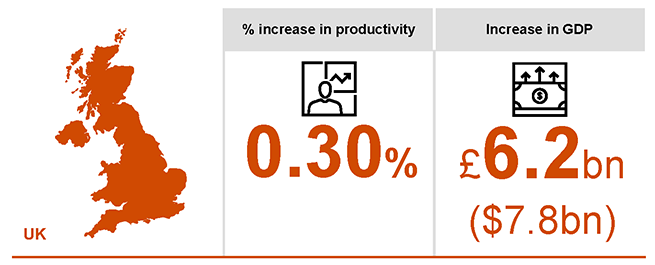This year, the report further explores the impact of gender equality on productivity and growth, with a particular focus on the UK and its performance compared to the OECD and G7 averages. The analysis seeks to build on existing research, that gender equality has a positive influence on economic growth, by quantifying the impact of female participation rates on productivity – offering a more comprehensive understanding of its economic implications.
Iceland ranks first on the Index
Iceland ranks first on our Index, followed by New Zealand and Luxembourg. Iceland’s strong performance was driven by an improvement on three out of the five indicators on the Index between 2022 and 2023. Iceland continues to have the highest female participation rate (83.7%) across the OECD. This can be partly attributed to Iceland’s generous parental leave policies and large childcare subsidies.
Ireland recorded the biggest improvement in its rank, rising from 12th place in 2022 to 6th place in 2023, with a 4.1ppt increase in its Index score. This was driven by an improvement across all indicators, with the exception of the female full-time employment rate. In particular, the gender pay gap fell by 2.9ppt (from 6.7% in 2022 to 3.8% in 2023).
You can explore our latest Index results and previous years’ results in the interactive data tool below.
The UK’s Index results in depth
Despite the UK’s Index score increasing by 0.7 points between 2022 and 2023, reflecting marginal improvements on most indicators, its rank fell from 17th to 18th place – the lowest it has been in over a decade. A widening of the participation rate gap in the UK from 7.1% in 2022 to 7.8% in 2023 contributed, but in large part the UK is being outpaced by other countries in terms of progress made towards achieving gender equality at work.
On our UK Regional Index, Scotland took the top spot this year followed by Northern Ireland in second and the South East in third. Scotland’s strong performance was primarily driven by an improvement in the gender wage gap, which fell quite significantly over this period from 11.8% in 2022 to 8.3% in 2023. Scotland also continued to record the lowest participation rate gap across the UK as of 2023 at 5.1%.
7.5%
Northern Ireland has lowest gender pay gap
64%
London has the highest female full-time employment rate
+6
North East jumped from 10th to 4th place in the rankings
78.3%
South East has the highest rate of female participation
“Across the OECD, progress towards gender equality at work remains slow, and at the current pace it will take 46 years to close the gender pay gap.”
“Continual improvements in female participation rates in the UK would lead to an aggregate increase in its GDP of approximately £43.5 billion by 2030.”
“Greater integration of women has the potential not only to boost productivity and economic growth, but also to enhance economic diversity, reduce income inequality and strengthen the overall skills base.”
Productivity analysis: Gender equality improvements positively impact productivity
Our longitudinal productivity analysis demonstrates the economic benefits of gender equality, particularly in terms of enhanced productivity and its contribution to economic growth. Our analysis seeks to quantify the impact of increased female participation on productivity through two channels: labour supply and workplace diversity. By increasing the available pool of talent and its allocation in the workforce, these factors increase productivity and result in GDP growth. We estimated these impacts across three scenarios.
Impact over the WiW index (2011-2023): Our analysis highlighted improvement in female participation over 2011 - 2023 revealed a productivity uplift of 0.30% per annum or 3.59% across the whole period. This contributed to an increase in GDP of approximately £6.2 billion ($7.8 billion) per annum in the UK, $4.5 billion average for the OECD and $15.2 billion for the average G7 country.
Impact of closing the gender gap by 2045: Our analysis further found that closing the gap between male and female participation levels over the next 20 years could contribute to a productivity uplift of 0.22% per annum across all 33 OECD countries on average. This would lead to an increase in GDP of approximately £4.7 billion ($5.9 billion) per annum for the UK, $3.4 billion for the average OECD country, and $11.2 billion for the average G7 country.
- Forecast impact to 2030: Continuing progress on female participation rates, if sustained up to 2030, could contribute to a productivity uplift of 0.30% per annum across all 33 OECD countries on average. This translates to an approximate UK GDP increase of £6.2bn ($7.8bn) a year, and £43.5bn ($54.7bn) by 2030. For the average OECD and G7 countries, these figures stand at $4.5bn a year, reaching $31.5bn by 2030 and $15.1bn a year, reaching $105.7bn by 2030 respectively.
UK productivity and GDP (per annum, 2023 GBP)

OECD, G7 productivity and GDP (per annum, 2023 USD)

Our research estimates the observable impacts of further integrating women into the economy. Greater integration has the potential not only to boost productivity and economic growth, but also to enhance economic diversity, reduce income inequality, improve adaptability to demographic shifts, and strengthen the overall skills base.
Note: In this year’s report, we present the latest Index results using 2023 data. A time lag in data availability across all 33 countries on our Index means this is the latest annual data available at the time of publication. When we refer to the latest results, we mean results based on 2023 data. (Similarly, our 2024 report provided the latest Index update using 2022 data, and so on). Our productivity analysis is based on data as of 2023 and reported in nominal terms.
Contact us









